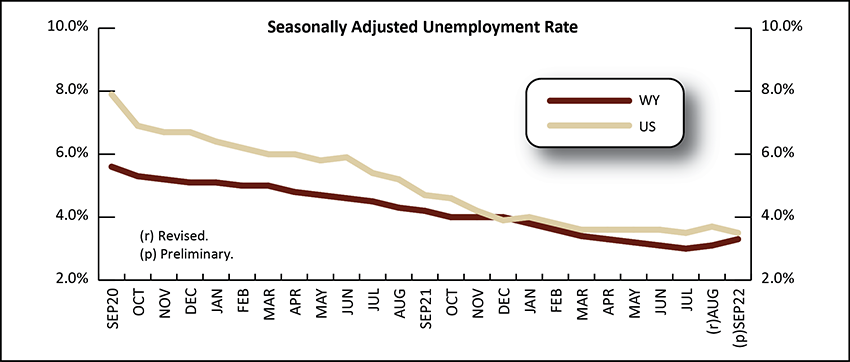Wyoming Labor Force Trends
November 2022 | Volume 59, No. 11
Click Here for PDF
Return to Table of Contents
Wyoming Unemployment Rises to 3.3% in September 2022
by: David Bullard, Senior Economist
The Research & Planning section of the Wyoming Department of Workforce Services reported that the state’s seasonally adjusted1 unemployment rate rose from 3.1% in August to 3.3% in September. Wyoming’s unemployment rate has stayed in the narrow range of 3.0% to 3.4% in each of the past seven months and is slightly lower than the current U.S. rate of 3.5%. From September 2021 to September 2022, Wyoming’s unemployment rate fell from 4.2% to 3.3%.
From August to September most county unemployment rates changed very little. Jobless rates fell in Crook (down from 3.5% to 2.4%), Platte (down from 3.2% to 2.9%), and Big Horn (down from 3.4% to 3.1%) counties. Slight increases were seen in Goshen County (up from 2.5% to 2.7%) and Teton County (up from 1.7% to 1.9%).
From September 2021 to September 2022, unemployment rates fell in most counties. The largest decreases were seen in Natrona (down from 4.7% to 3.7%), Campbell (down from 4.2% to 3.3%), Sublette (down from 4.2% to 3.4%), and Converse (down from 3.5% to 2.7%) counties.
In September, the lowest unemployment rates were found in Teton County at 1.9% and Weston County at 2.2%. The highest rates were reported in Sweetwater County at 3.8%, Natrona County at 3.7%, and Uinta County at 3.5%.
Total nonfarm employment in Wyoming (not seasonally adjusted and measured by place of work) rose from 283,800 in September 2021 to 291,500 in September 2022, an increase of 7,700 jobs (2.7%). Employment was unusually low in 2021 because of economic disruptions related to the pandemic.
R&P's most recent monthly news release is available at https://doe.state.wy.us/LMI/news.htm.




.svg)
 Wyoming at Work
Wyoming at Work